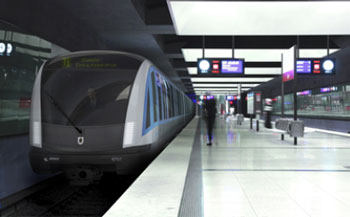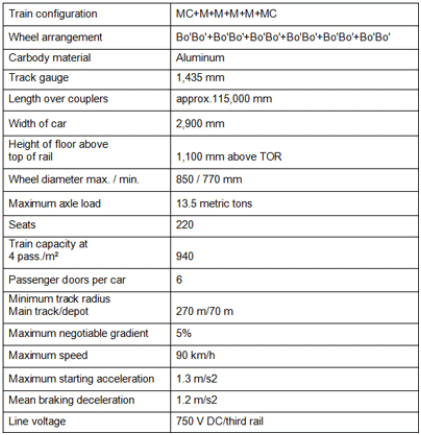Siemens presents the first carbody for Munich’s new metro trains
- Like
- Digg
- Del
- Tumblr
- VKontakte
- Buffer
- Love This
- Odnoklassniki
- Meneame
- Blogger
- Amazon
- Yahoo Mail
- Gmail
- AOL
- Newsvine
- HackerNews
- Evernote
- MySpace
- Mail.ru
- Viadeo
- Line
- Comments
- Yummly
- SMS
- Viber
- Telegram
- Subscribe
- Skype
- Facebook Messenger
- Kakao
- LiveJournal
- Yammer
- Edgar
- Fintel
- Mix
- Instapaper
- Copy Link
Posted: 8 October 2012 | Siemens | No comments yet
In a ceremony Siemens Rail Systems Division presented the first painted carbody of the new metro trains…


In a ceremony in its Vienna plant, the Siemens Rail Systems Division has presented to the Munich City Utilities (SWM) the first painted carbody of the new metro trains ordered for the Munich transit company MVG. It is the end section of the first of 21 C2 type six-car permanently coupled trains, which the SWM/MVG ordered from Siemens at the end of 2010. This was the largest order for rolling stock in the history of the Munich Underground. The investment totals about 185 million euros. At the same time, SWM/MVG took out two options on a further 23 metro trains, for a total of 276 cars, which can be transformed into firm orders until 2016 and 2020, respectively. This would increase the total investment to around 550 million euros. The new trains are being built in the Siemens plants in Vienna, Austria, and in Munich-Allach, Germany. From the seventh train onward, final assembly will take place in Munich.


The highlights of the new C train include not only its high passenger capacity, acceleration rate and availability, but also its end-to-end accessibility (i.e. it is a permanently coupled train without any self-contained cars), its interior layout and wide passenger doors. Remarkably, the train is also more than 95 percent recyclable and especially energy-efficient thanks to the recovery of up to 50 percent of the braking energy. The design is based on the well-known appearance of the C car of the previous generation of vehicles, which was developed by Alexander Neumeister, the internationally renowned Munich vehicle designer.
The following changes are planned for the C2 in comparison with the first generation C train (series C1.9 and C1.10 with a total of 18 trains and 108 cars):
- Ever better passenger interchange and higher capacity due to enlarged standing areas in the gangways between the car sections, thus also creating more space for baby carriages and wheelchairs
- Improved indication of the door opening and closing sequences by means of colored LED light strips in the door edges: inside above the double-leaf doors and outside between the door leaves and rubber lips of each double-leaf door.
- A slightly modified front section with new lighting equipment based on LED technology to create a sleeker appearance.
- Redesigned interior lighting using low-maintenance, energy-efficient LED lamps instead of the previous halogen spotlights to produce more even and pleasant illumination.
- All seats are padded. Wooden seats have been eliminated because ten years experience has shown that wooden seats damaged by vandals are more expensive to repair.
- Optimized technology reduces power consumption, maintenance costs, and improves diagnostic capabilities so that faults can be rectified more quickly.
- The systems used also require very little maintenance, which lengthens maintenance intervals and increases the availability of the metro fleet.
- Higher maximum speed: 90 km/h instead of the previous 80 km/h
- Factory-equipped with CCTV surveillance cameras, passenger TV and fire protection measures (sprinklers)
- Pre-equipped for driverless operation (i.e. driver’s cab can be eliminated or greatly reduced to increase capacity even further)
Even more space for passengers
Changes in the seating arrangement have created more space for additional passengers. The C2 train will accommodate a total of 940 passengers instead of the previous 912. It will have 220 seats and standing room for 720 passengers, thus increasing the total capacity by 28. That corresponds to three percent more space in comparison to the previous C train. The new C model can also carry eight percent more passengers than the even older vehicles in the MVG fleet. This is a crucial factor for ensuring fast passenger interchanges at the station platform, especially in view of increasing ridership. The basic seating concept remains unchanged, with some seats arranged longitudinally and some arranged face-to-face. This satisfies not only the various customer preferences but also the international standard for metro vehicles.
Technical data of the C2 metro for Munich


The 21 trains ordered are scheduled to be delivered between 2013 and 2015. Some of the trains are intended as replacements, some as additions to the fleet. Fourteen trains will replace old rolling stock which is to be scrapped after more than 40 years in service. Keeping them in service beyond 2013 and 2015 would be uneconomical in view of dramatically rising maintenance costs. On top of that, after 40 years, an increasing number of spare parts are simply no longer available. Seven trains will be needed for the first phase of the 2010-2020 MVG service campaign. This calls for trains to run at two-minute headways over downtown line sections as of 2014. Up till now, the minimum service interval has been 2.5 minutes. If ordered, the rolling stock covered by the option could be delivered as of 2017-2018 to replace other obsolescent vehicles and provide more frequent service. About 60 percent of the city’s metro fleet is scheduled for replacement by 2025.



